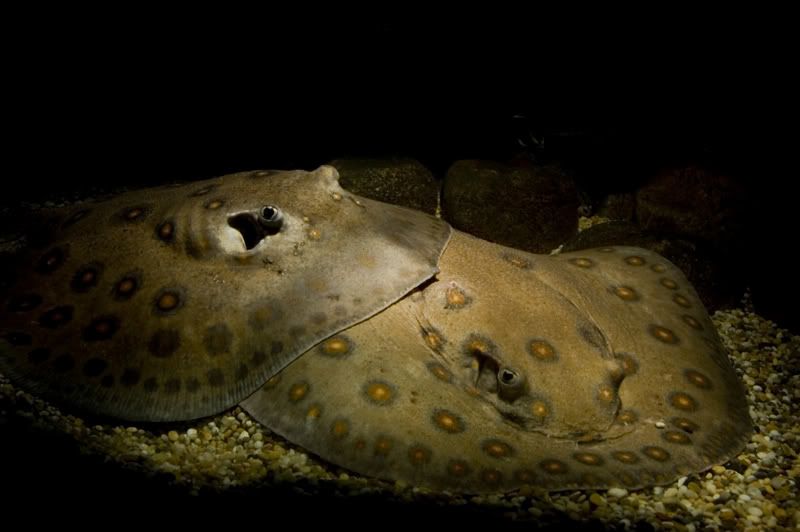In my previous blog post i touched upon the occurrence of hybridizations between the different species of the genus Potamotrygon, which suggests a close relationship between the species. Most of the around 18 described* species in this genus show a large range of coloration patterns. Giving a example, there are several variants of P. motoro (just searching on Google for pictures reveal the range). there are everything from plain motoro rays with a dark brown background color and orange spots to the marbled variants with all their amazing patterns. Given that the other species in the genus also show this polychromatic appearance make it difficult sometimes to draw lines between the different species. This makes it important to use new tools to be able to establish the evolutionary origins and relationships between the different species in the genus and also within the Potamotrygonidae family.
 |
| Figure 1. My old pair of P. motoro with the male showing courting behavior. This pair was wild caught, the male was from Colombia and the female from Peru. |
The Potamotrygonidae family is the only family of batoids that all included species are fully freshwater. The closest extant relatives of Potamotrygonidae rays are sea living pacific stingrays of the genus Himantura. Therefore the proposed origin of this family is that a group of Himantura rays from the pacific got landlocked and ended up in what now is the amazon area of south america. Another hypothesis is that a group of these rays wandered into freshwater from the north down into the amazon area at the time before the emergence of the isthmus of Panama.
A study by Daniel Toffoli and colleges published 2008 used a method called DNA barcoding to resolve the evolutionary relationship between 10 of the described species of Potamotrygonidae stingrays with a Himantura ray, another ray and a shark as outgroups. The point of this method is to in a quick and easy way be able to identify what species of an organism you are dealing with when the morphological data are conflicting. They wanted to test if this method would work to distinguish these species from one snother. They extracted, amplified and sequenced a gene called mitochondrial cytochrome oxidase I (COI) from several specimens of several different localities from each species. They used the sequences to produce phylogenetic trees using three different methods, Neighbour Joining, Maximum Likelihood and Bayesian Likelihood.
Using these methods the authors show that it is, using this gene, impossible to sort out the interspecies relationship in this family other than that what they call the rosett spot clade is a well supported clade of more closely related species. The trees also show that Plesiotrygon iwamae, P. shroederi, P. sp 1, P. henlei, P. falkneri, P. leopoldi and P. cf. motoro all seem to form distinct monophyletic species using samples from the different locations. The three other species form all together a clade where it is hard to determine the species of each individual from molecular data alone, ie. they seem to share haplotype in this gene. Thus the data seem to show P. motoro as a paraphyletic species as seen in the simplified sketch below(figure 2).
There could be many reasons for this strange appearance in the tree where a individual of one species seem to be closer genetically to another species than to its own kind. One possible reason is a poor identification of the individuals, however P. scobina and P. orbignyi differ quite much from P. motoro in colours and patterns so this seem unlikely. A second possibility is that this gene is so well conserved in this linage so that there isn't enough informative sites to produce a reliable phylogenetic tree. The third option is that the divergence of these three species is so recent in time that they haven't yet completely formed their own distinct haplotype. In this scenario P. motoro could be considered the ancestral species of the other two as the authors suggests. This is an intriguing scenario are we actually looking at speciation while it is taking place in realtime? A final scenario is that the Potamotrygon genus actually represents the full spectra of a highly polychromatic species, however this may be the least parsimonious explanation .
This paper leads you to very interesting questions. To fully resolve these questions one would have to look at more genes and possible more individuals (as the authors also say) to fully confirm the reason for this tree topology. If this is the case, that P. motoro is a species which are undergoing a divergence into the three species, this could explain the possible hybridization of the different species that are known to occur in aquariums.
*It remains a few species waiting to be described!
References:
References:
Toffoli, Daniel, Tomas Hrbek, Maria Lúcia Góes De Araújo, Maurício Pinto De Almeida, Patricia Charvet-Almeida, and Izeni Pires Farias. “A test of the utility of DNA barcoding in the radiation of the freshwater stingray genus Potamotrygon (Potamotrygonidae, Myliobatiformes).” Genetics and Molecular Biology 31, no. 1 (2008): 324-336.


No comments:
Post a Comment